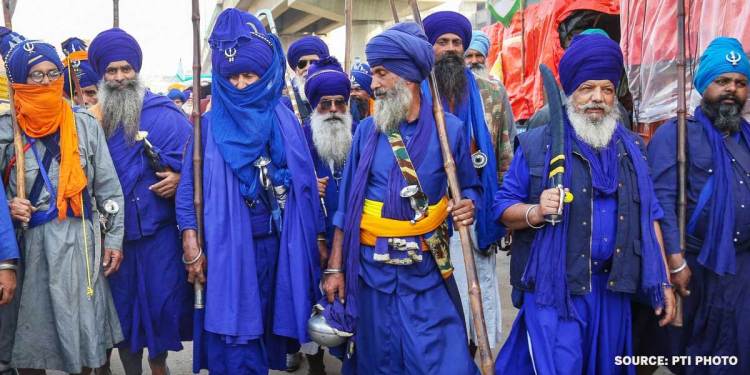
Explainer | Nihang Sikh sect in spotlight again after Singhu killing

The murder of a man at the farmers’ protest site at Singhu border of Delhi on Friday morning (October 15) has put the focus back on Nihang Sikhs, who, farmer leaders allege, were behind the killing.
Samyukta Kisan Morcha (SKM) leader Balbir Singh Rajewal said the man was found hanging from a barricade at Singhu with a chopped hand.
In April 2020 too, a group of Nihangs had attacked a Punjab police party in Patiala and chopped off the hand of an assistant sub-inspector when stopped for a curfew pass.
Who are Nihangs?
Sikh warriors, who wear blue robes, carry antiquated arms like swords and sport turbans mounted with steel quoits.
Traditionally known for their bravery and ruthlessness in the battlefield, the Nihang once formed the irregular guerrilla squads of the armed forces of the Khalsa Empire, the Khalsa Army.
The word ‘Nihang’ owes its origin to Mughal historians, who compared the ferocity of the Akali with that of crocodiles. The meaning of Akali in Sikhism however, is the immortal army of Akal (god).
Sikh historian Dr Balwant Singh Dhillon told The Indian Express: “Etymologically the word nihang in Persian means an alligator, sword and pen but the characteristics of Nihangs seem to stem more from the Sanskrit word nihshank which means without fear, unblemished, pure, carefree and indifferent to worldly gains and comfort.”
Professor Paramjit Singh Judge of the Department of Sociology, Guru Nanak Dev University, Amritsar, told The Print: “The Nihangs are not one consolidated sect or group. There are divided and while following the same traditions and norms, they have their own independent deras, some of which are at loggerheads with one another for prominence.”
Some historians described Nihangs as “unaffected by pain or comfort”, “given to meditation, penance and charity” and “complete warriors”.
Over the years though criminal elements have entered several Nihang deras, said Judge, who has extensively studied the lives and culture of the community.
Origin
The tribe traces its origin to the founding of the Khalsa Panth by the 10th Sikh Guru, Gobind Singh, around 1699. Several historians say the sect calls itself to be “guru di laadli fauj” (the guru’s favourite army).
Also read: Man’s body, wrist cut off, found tied to police barricade at Singhu protest site
The armed sect has its beginning in the Akaal Sena, a band of soldiers of Guru Hargobind, the sixth guru. Later, the Akaal Sena metamorphosed into the ‘Khalsa Fauj’ of the 10th guru.
The contribution of Nihangs in defending Sikhs during repeated attacks of Afghan invader Ahmed Shah Abdali in the 18th century is well remembered. As a mark of honour, the community was accorded an important position in the army of Maharaja Ranjit Singh.
Judge says there are multiple stories about the origin of the Nihangs. “One story is about their having been a part of the Akaal Sena and later Khalsa Fauj. But unlike the Udasi sect and the Nirmalayas who can be clearly traced back to the Sikh gurus, there is no concrete historical evidence of the origin of the Nihangs,” he said.
The sect today is accorded great respect and affection by sections of the Sikh community, but they have separate beliefs and certain practices. While the order is primarily ceremonial, they are duty-bound to defend their people and faith in times of war. Nihang gather in their thousands at Anandpur, in the state of Punjab, India. Located near the Sutlej River, the city is one of the most sacred places in Sikhism, where they display their martial skills.
Difference between Nihangs and other Sikhs
Khalsa Sikhs are of two types –Those who put on blue attire which Guru Gobind Singh used to wear at the time of battle and those who do not follow any particular colour of dress. Both, however, are warriors and are brave, as per record written by the East India Company’s Colonel James Skinner (1778-1841).
Also read: For Cong, promoting Dalit Sikh as CM a double-edged sword
Nihangs are the ones who strictly follow the Khalsa code of conduct. “They do not profess any allegiance to an earthly master… Instead of saffron they hoist a blue Nishan Sahib (flag) atop their shrines,” said Sikh historian Dr Balwant Singh Dhillon.
Some popular slogans of Nihangs, in the face of adversities, are ‘chhardi kala’ (forever in high spirits) and ‘tiar bar tiar’ (state of ever preparedness).
The influence of Nihangs came down after the fall of Sikh Empire in 1849 with the rise of the British.
Where do Nihangs stand today?
The Nihangs are a very small community today which are loosely organised in the absence of a central authority. There are about 12 deras (bands) of the community and each dera is headed a jathedar (leader). Some well-known Nihang bands are Budha Dal, Taruna Dal and their factions.
They live in deras and come out only during their annual pilgrimage of Anandpur Sahib, Damdama Sahib Talwandi Sabo and Amritsar.
The community is known for showing martial art skills and horsemanship. Dr Gurmeet Singh Sidhu, professor-in-charge Guru Gobind Singh Chair at Punjabi University, Patiala, told The Indian Express: “With the advent of modernity, the balance between Bani (Guru Granth Sahib) and Bana (outer form) broke down, resulting in problems and unethical actions. Earlier, Nihangs would never attack an unarmed person.”


